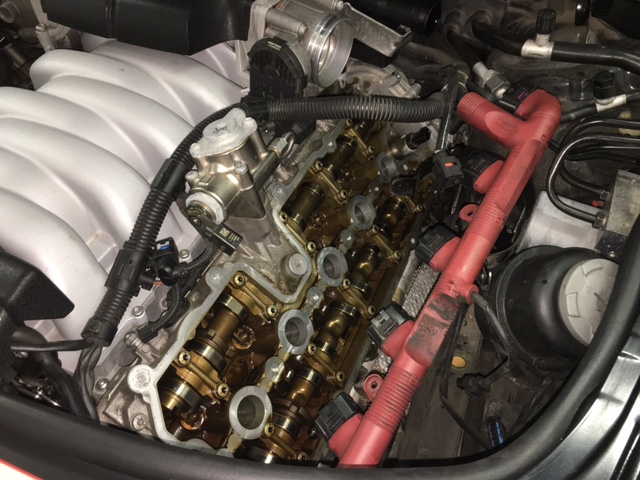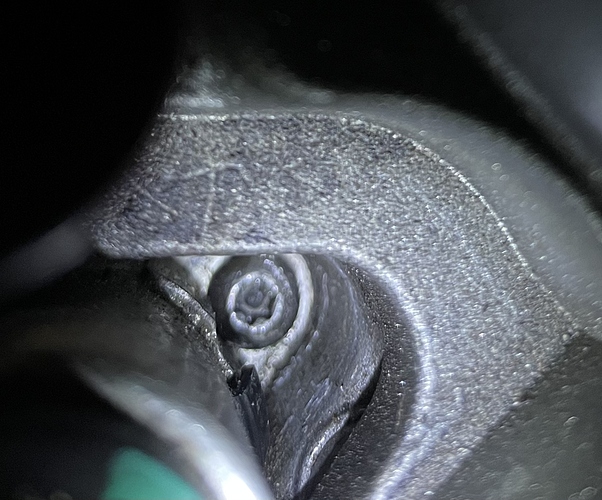Forgot to add this picture, shows the value installed with valve cover off:

I think I have this problem on my car but on the passenger side. Do you just remove the plug and then a single bolt to remove the solenoid? I assume the solenoid is located just behind the last cylinder on the back of the engine?
The solenoid is held in place by one small bolt. Do not need to remove any plugs.
The valve cover doesn’t have to come off to access the solenoid does it?
No, it does allow you a bit easier access to the bolt and to faciltate clean up.
Is there a part number for just the o ring gasket?
I replaced all 4 o-rings last time I had my intake out. But now I think I have a problem with that exact solenoid—I’m getting a P0023 fault. I just measured the resistance and it shows 10 ohms, where spec is 5-8 ohms. I also checked the intake solenoid and it read 8.8 ohms. Maybe time to replace both? The ones on the passenger side seem like they are harder to reach.
@Korndog101 I’m looking at the first photo where you showed where the solenoid is located. Was this photo take after you had cleaned up the area? I’m pulling mine out right now and I’m not noticing much oil residue. Based on your first photo yours doesn’t have a lot of oil residue either assuming you haven’t cleaned it yet.
I’m doing this because I’ve got the same oil smell and smoke coming from under the hood when I’m not moving.
So I got all VVT solenoids pulled out today to replace the o-rings. It seems to have fixed my oil burning issue. I was skeptical at first because I was looking around the solenoid and did not see much sign of oil leaking, but I think there is some small channel that is covered by the valve cover that I couldn’t see.
I ordered my parts from FCP Euro and got them much faster than I expected. The part number was WHT002789 and I ordered 4 of them.
The screw that holds the solenoid in place is a T20 Torx screw.
Hopefully this info will help someone in the future when they stumble upon this thread.
Yeah those o-rings get hard and start to leak. Cheap and easy fix compared to the vast majority of issues with these cars.
while we are on the subject, is there a howto guide on changing the solenoids on the passenger side? I just see a tangle of hoses hiding the solenoids.
Just have to remove everything until there is room. Honestly not the best answer but it is true.
I took the intake tube off. moved the coolant bottle out of the way. unplugged all the nearby connectors, took out the coil pack that is right next to it, and undid the PCV tube from the valve cover.
Having a t-handle T20 makes a difference also.
Thanks for the tip, need to get some of those T-Handle torx wrenchs. I need to get orings replaced on the other three.
Did you try to remove the solenoid? Or Does your T-handle t20 have a “hollow” tip. The one I bought does not, and from the photo it appears that there a dot on that screw.
I used a standard torx head socket, worked fine.
I found it easiest to use a 12" extension as I was able to see down in that tight area a little clearer from further back.
I just had my car re-sealed for $$$$. Still a smoke house asphalt machine driving experience. If it was this dang solenoid the whole time… =)) welp, at least I got new alt, starter and a steering pump pre-emptively at the same time
I’m reaallly hoping the problem is this. Otherwise the engine may not be sealed properly. I find that highly unlikely.
As I just did this I will add a few tips.
Gain access to all 4 solenoids by removing passenger intake tubes and box, releasing coolant reservoir, and driver’s side intake tube, pcv box and valve cover to cover hose.
You will need multiple 1/4 extensions (pivotable is best), t20 bit, t20 t handle (for passenger intake solenoid, 1/4 socket does not fit past the solenoid casing and the engine hoist). Passenger side exhaust solenoid if you look from the fender at it, they seemed to have left a tunnel through the hoses for access with extensions. Smaller size telescoping magnet! (For removing bolts from holes and starting the threads after. Vacuum.
Before you remove the solenoids take a pick and loosen the dirt in the hole and vacuum it out, you do not want to drop sand in these holes.
Pretty much the hardest part if they are in there good is gently prying from different angles until you can get the solenoid to loosen and spin before attempting to remove.
These solenoids have a high failure rate and it isn’t just the orings!
If you are reusing, once you remove check for play in the casing, resistance is 5-8 ohms. Other failure point is the plugs on the harness side! Voltage was 3 at accessory on.
I had no leaks and all resistances tested within factory specs but had 3 solenoids loose in the casing, one almost about to actuate itself out. I also had 3 plugs, looked fine, but the male inside where terminals lock in were broken at the stem under the gasket.
Do not drop bolts! Do not over torque these bolts!

